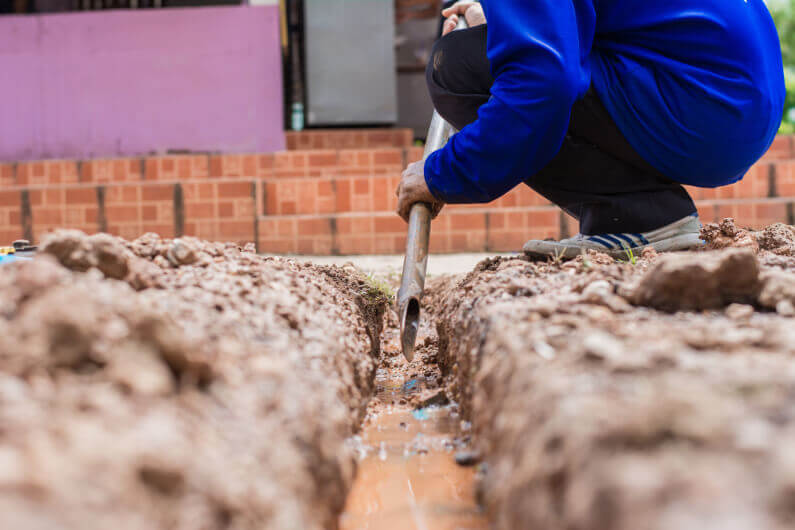
How To Detect Warning Signs of an Underground Leak
Did you know there are more than 240,000 water main leaks per year in the US?
Most of us are pretty aware of the plumbing within our homes, but an underground leak can be absolutely devastating.
Your best defense? Catch them early, before they become a serious problem. The longer an underground leak is left the more damage it’ll cause to your property.
Since these lines are buried, however, it’s often hard to find out what’s going on until serious property damage has already happened. If you suspect a problem then read on and we’ll show you how to catch these leaks as soon as possible.
The Obvious Signs of an Underground Leak
Underground leaks can be tricky things, but if they’ve been going on for any significant length of time there will be some obvious signs.
The most obvious are sinkholes. These occur when the water underneath the surface begins to erode the soil around the pipe, allowing a chunk of soil to collapse into the ground and creating a major hazard in your yard.’
Other obvious signs that you have an underground leak include the following:
- Consistent wet patches in one area of your yard
- Puddles on concrete or asphalt that never seem to completely dry
- Sudden spikes in water usage leading to higher bills
The first two are definite signs that you’re dealing with an underground leak, but the third can also indicate a leak somewhere in the home.
If a rise in your water bill is the only indication you should leak check your sinks, faucets, showers, and toilets. If all of these are tight and not leaking then chances are an underground leak is the culprit.
Sudden Drops in Pressure
If you suddenly find that your water pressure has dropped through the whole house then an underground leak can be the culprit.
A single appliance, such as a faucet, suddenly dropping pressure still indicates a problem of course. In that case, you should see if you can trace out the leak through the water supply to the problematic faucet, toilet, or shower.
On the other hand, if the pressure goes down through the whole house at once then you’re most likely looking at a broken water main.
Depending on the drop in pressure you may be dealing with a fracture or even a completely burst pipe and it’s time to call in a professional.
Checking the Meter
Often when an underground pipe is leaking but not causing damage just yet you can detect it with the meter.
The first step is to shut down the water where it enters your home. Turning off this main will kill the water supply to your home and isolate the problem to the pipes which run underground.
Leave the meter off for some time and then check to see if it’s still racking up. If it is, then you have an underground leak.
Checking the meter is easy enough. Most modern meters have a flow indicator which shows the current water usage in the home. If you’ve shut the water off at the main and the flow indicator is showing higher than zero… well, you’ve got a leak.
If your meter is an older type then write down the number indicated and come back a few hours later and see if the numbers match up. When you return if they don’t line up… you’ve got a leak.
Steps to Take After Detecting an Underground Leak
If you’re dealing with a leak in the main you’ll want to call in a professional as soon as possible.
In addition to running up your water bill, underground leaks can cause a surprising amount of damage if they’re left to run unchecked.
One of the best things to do while waiting for a plumber to arrive is to see if you can’t find the general area the leak is in. You’ll want to go over your yard looking for wet or muddy spots and if you can’t find anything it may be a wise idea to check in the crawl space.
Crawl space leaks can be harder to find, especially since there’s often plastic tarping placed over the ground beneath a home. Instead of tearing up the plastic you can check for areas where visible condensation can be seen on the underside of the tarping.
Identifying the rough area the leak is in will help out your plumber quite a bit, but it’s not always possible. If you can’t find the location of the leak then you may need to wait for your plumber to find it.
Give it your best shot, however, as you can save both yourself and your technician some time in doing so.
Slab leaks can be hard to find, usually only emerging as a perpetual dark spot on the concrete. Even then, you’ll only be able to find them if the leak is large enough to saturate the concrete.
There’s another thing to keep in mind as well. If the leak is before the water meter it’s actually the local government’s responsibility and not your own.
Getting the Right Help
When it comes to detecting underground leaks the average homeowner should be able to at least isolate the source, even if they’re not able to directly find the leak.
Fixing the problem is another matter entirely. When it comes to having to dig up and replace the underground piping which brings water into your home it’s not time to start cobbling together a DIY solution.
Instead, you’ll need a well-versed professional. If you’re in the Tulsa or Broken Arrow area then contact us and let’s make leaky pipes a thing of the past.
